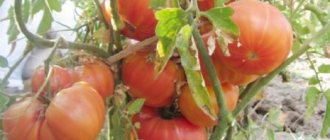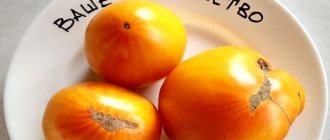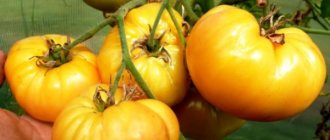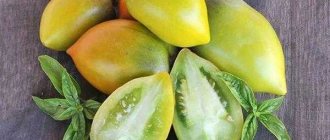The Pink Pearl tomato will appeal to lovers of delicate pink tomatoes, which perfectly complement the taste of salads and other dishes. They ripen early, so you can enjoy them almost from the beginning of summer.
| Height | Landing location | Ripening time | Fruit color | Fruit size | Origin | Fruit shape |
| short | Greenhouse, Open ground | Early ripening | Pink | Average | Variety | Round |
Description of the variety
More recently, the cultivation of pink varieties of tomatoes was the lot of residents of the southern regions. Today, breeders introduce new species almost every year. The Pink Pearl tomato variety is cherry tomatoes, which are distinguished by the delicate color of the fruit, their density and fleshiness. And also extremely unpretentious in care.
The variety can be grown throughout the country. Breeders recommend growing tomatoes in open ground or in containers on a balcony or veranda. However, judging by the reviews, the Pink Garden Pearl tomato develops well and bears fruit in greenhouses and film shelters. You just need to choose the right place for it and not plant it next to tall, spreading tomato varieties.
The Pink Pearl tomato, described in the article, is a low-growing determinate plant. Its height is only 30-40 cm. It forms creeping shoots covered with simple green leaves. The bush does not need to be formed or provided with supports. Forms yellow inflorescences collected in brushes of 8-10 pieces.
The attractive appearance of tomatoes makes the Pink Pearl variety a favorite of many cherry fans. The fruits are smooth, round or rounded-elongated. Cherry weight – 15-20 grams. The skin is a delicate pink color with a slight glossy sheen. The number of sections with seeds reaches three, which does not prevent the tomatoes from remaining dense and fleshy, but adds juiciness. Cherry has an excellent taste, with pronounced sweet notes and a delicate aroma.
Interesting fact! Tomatoes of the Garden Pink Pearl variety contain the substance lycopene, which destroys fatty tissue and, together with its low calorie content, makes the variety indispensable for weight loss. The excellent taste of tomatoes will help you stay on track when following a diet.
The Pink Pearl tomato is an unpretentious crop that does not require special attention other than standard procedures: watering, fertilizing and harvesting. The only thing that needs to be provided for a low-growing plant is access to light.
Tomato variety Garden Pearl
The SeDeK agricultural firm pleased gardeners with an unusual variety with the beautiful name Garden Pearl. The plant not only looks decorative, but also has excellent taste. The tomato is new, it was included in the State Register of Breeding Achievements of Russia in 2017 and received permission to be grown in all regions of the country. Recommended for open ground and film greenhouses of private farms. The new product was highly appreciated in Moldova and Ukraine. Our hero is not a hybrid.
Description
The plant is determinate, low, 30-40 cm high. The shape of the bush is creeping, so the variety is convenient to grow in hanging pots as an ampel plant. It looks very elegant, and it is interesting and convenient for children to harvest. Shoot formation is good. The stem and stepsons are of medium thickness, but very strong, and do not break under the load of the crop. The leaves are medium in size, regular in shape, dark green. The inflorescence is simple. The fruit cluster consists of 8 - 10 ovaries. The first brush is formed above the 4th - 5th leaf. During the season, the prolific bush of the Garden Pearl produces from 300 to 500 tomatoes.
The fruits are medium dense, round in shape, smooth. An unripe tomato is light green in color without a dark spot at the stalk. When ripe, it becomes pink, with a pearlescent tint. The skin is quite strong, but not hard. The pulp is juicy, aromatic, there are 2 - 3 seed nests, the seeds are very small. The taste is excellent, the taste is sweet, with a slight sourness. The fruit size is small, weight - 15 - 20 grams.
Characteristics
- The amazing Garden Pearl is an ultra-early ripening variety. She will delight you with a harvest within 87 - 93 days after the appearance of full shoots;
- The crumb yield is excellent due to the growth of side shoots on which fruit clusters appear. According to different sources, this figure is quite high - from 2.0 to 7.0 kg of tomatoes per bush. True, the State Register notes that 4.8 kg per 1 square meter was collected under film covers;
- the fruiting period is long, the plant will form ovaries before the onset of persistent cold weather;
- there is no specific data on immunity, but the Garden Pearl is reported to be resistant to major diseases;
- fruits are resistant to cracking;
- transportability is good, tomatoes can withstand the hardships of transportation. Keeping quality, according to reviews, is long-lasting if storage standards are followed;
- method of use is universal. Children love to pick sweet tomatoes and eat them in their natural form. You can make a salad from the fruits and decorate the finished dish with them. Another advantage of the variety is the ability to use it in whole-fruit canning.
Agricultural technology
It is best to grow Garden Pearl using seedlings. The seed sowing period is from March to April. Picking in the phase of 2 true leaves will definitely be required. The transplant takes place in May or early June. Recommended density is no more than 4 plants per 1 square meter. Do not save space, as during the fruiting period the bush spreads out very much and can take up to half a meter of area. To the delight of busy gardeners, there is no need to shape the plant. On the contrary, the more stepsons are formed, the more productive the bush will be. But it is recommended to pick ripe fruits in time so that the plant switches nutrition to the formation and ripening of new tomatoes. Care is usual, but the variety needs to be planted in well-drained and nutritious soil.
Characteristics
The characteristics of the Pink Pearl tomato indicate that the variety is well adapted to changeable weather conditions. It is quite cold-resistant. Does not stop the formation of ovaries during periods of prolonged cold weather. Not prone to developing fungal diseases associated with cool and damp weather. However, this variety is not frost-resistant. The bush can die even at zero temperatures.
The variety is early ripening. Ripens in 85-95 days. Fruiting is extended, and under favorable conditions can last up to three months.
Photos of the Pink Pearl tomato, in which the bushes are strewn with fruits, suggest that the variety is high-yielding. And indeed it is. From one square meter you can get up to 4.5 kg of mini-tomato, which is not bad for such a miniature plant.
The productivity of the Pink Pearl tomato largely depends on the fertility of the soil. The variety responds well to fertilizing with nitrogen and mineral fertilizers.
The fruits of the Garden Pink Pearl are covered with a very dense skin. They do not crack either on the branch, or during storage, or during transportation. Cherry Pink Pearl can be stored in the refrigerator for up to one and a half months. Placed in a single layer in a dark, cool room, they will remain fresh for about a month.
The taste of tomatoes and the beauty of the fruit make the variety ideal for fresh consumption, salads and snacks. It is also ideal for canning.
"Pros and cons"
The Pink Pearl variety is a good choice for fans of miniature tomatoes. And also for everyone who wants to grow juicy and tasty tomatoes at home: on balconies, loggias, verandas. It is different:
- compact and decorative bushes;
- versatility in cultivation;
- unpretentiousness in care;
- high productivity;
- excellent taste and product qualities;
- long storage period without loss of beneficial properties.
Disadvantages include demands on soil fertility and the need for frequent fertilizing.
Bush care
What care measures are needed:
- Water the tomato crop regularly. Watering is carried out directly under the bush, since moisture that gets on the foliage can provoke the occurrence of many diseases;
- Each watering procedure should be completed by loosening. Thanks to it, air exchange improves, which allows the root system to develop normally;
- The tomato does not need to form a bush;
- The variety responds well to the application of both organic fertilizers and mineral complexes;
- Bushes are hilled as necessary.
An important step is to install reliable supports; this will avoid possible breaking of branches with a large number of ripening fruits.
Planting and care
The early ripening of the Pink Pearl tomato variety allows it to be grown in the southern regions by direct planting of seeds in ridges. In the middle zone you will have to resort to sowing seeds for seedlings. It is held during March.
- If they plan to grow it in a greenhouse, then in the middle of the month.
- For open ridges, the dates are shifted a couple of weeks later.
- For closed balconies and loggias, seeds are sown immediately in a permanent place in the second half of February.
It is important! The Pink Pearl variety has recently appeared on the seed market. Therefore, you should beware of fakes. It is better to purchase seeds from trusted suppliers or the originating company - agro. There is no need to abandon the pre-sowing treatment of seeds in a solution of phytosporin or manganese potassium.
You buy the soil or prepare it yourself. In principle, today there is a large assortment of specialized mixtures on sale that are suitable for planting tomatoes. It is worth paying attention to the content of potassium and phosphorus in them.
Seeds are sown in furrows up to 1 cm deep in well-moistened soil. Sowing is carried out according to the 3 x 2 cm pattern. Mulch, water, cover with glass and leave to germinate in a warm place. With the appearance of 2-4 true leaves, the plants are planted in separate containers. The seedlings are watered, fed with complex fertilizers and hardened off.
It is better to prepare the place for planting tomato seedlings in the fall, since the Pink Pearl tomato variety loves fertile, organic-rich soil. To do this, dig up the area, remove the remains of plants and their roots. Add compost at the rate of two buckets per square meter.
Plants are planted in holes filled with a mixture of humus and compost, wood ash and potassium-phosphorus fertilizers and spilled with plenty of water. Due to the miniature size of the bushes, they can be planted up to 7-9 pieces per square. The holes are filled in and the root circle is mulched with peat or sawdust.
Growing tomatoes
To grow the Pink Pearl tomato, it is better to use the seedling method.
How to prepare seeds?
Before sowing, be sure to disinfect the seed material in a manganese solution. After the procedure, the seeds must be washed in clean water.
Sowing seed material
Description:
- Planting of seed begins in late February - early March. The specific timing is determined by the region of growth and growing conditions (at home or in a greenhouse);
- To grow seedlings, special containers filled with disinfected soil are used. A hot, concentrated manganese solution is effective for killing fungal spores. It is used to soak the soil directly into the container. Drying the soil is not required, you just need to cool it to +25...+30 degrees;
- The seed material is laid out on prepared soil and sprinkled with a small (0.5 cm) layer of sand. The containers are covered with a glass or film cover on top and placed in a warm room. To ensure normal air circulation in a kind of mini-greenhouse, gaps are made. The seeds will germinate after 4-5 days;
- 14 days after the first shoots appear, the first pair of full-fledged leaves will form. At this point, the young seedlings are planted in separate pots and left in a relatively cool room with good lighting. Temperature range within +16…+20 degrees.
Rules for planting seedlings
Description:
- Tomato bushes begin to be replanted to a permanent place in the second ten days of May - early June;
- It is advisable to choose a bed where cauliflower, cucumbers, carrots, herbs or zucchini grew last year. It is better to grow the variety in light, highly fertile soil;
- Stretched tomato seedlings are placed horizontally in grooves 20 cm deep, leaving 4-5 leaves above the surface. Be sure to adhere to the recommended planting pattern - 30x30 cm. From 7 to 9 tomato seedlings are planted per 1 m2.
Diseases and pests
The Pink Pearl tomato variety is resistant to most diseases. When planted in open ground in the second half of summer, a tomato may develop late blight. To avoid problems, plants are regularly inspected, fruit-bearing shoots are cut off, and sprayed with a phytosporin solution.
If the disease manifests itself in the form of curled or blackened leaves, the bushes are sanitized and the affected branches are removed. Copper sulfate, Bordeaux mixture and fungicides are used for control.
Tomatoes are rarely affected by pests. Among the most common are whiteflies and spider mites. Most often they appear in greenhouses. They are fought with chemicals.
What does the plant suffer from and how to treat it?
An important characteristic of the variety is resistance to disease; it is especially immune to late blight. All that is needed for the plant to feel good is not to flood or overdry the soil; if the tomato is growing in a greenhouse or at home, regularly ventilate the room.
Sometimes bushes can be attacked by melon aphids and thrips. Treating bushes with insecticides, for example, “Zubr”, rids the plant of pests.
The most dangerous enemies of tomatoes growing in open ground are slugs and mole crickets. Effective ways to combat them are to loosen the soil and treat it with mustard or red pepper solutions.
Reviews from gardeners who grew the Pink Pearl variety are almost always positive. Tomato pleases vegetable lovers not only with delicious fruits in large quantities, but also with the aesthetic appearance of the bushes. It is better to buy plant seeds from trusted suppliers. This variety of tomatoes will appeal to every gardener.
Fans of early tomato harvests will certainly be interested in a tomato variety called “Pink Pearl”. The taste characteristics of the fruit will be adequately appreciated. In addition, to grow the Pink Pearl tomato, you do not need to have a personal plot, since the variety can be grown at home, even on the balcony.
"Pink Pearl":
Reviews from gardeners
Olga, 28 years old, Belgorod The Garden Pink Pearl tomato variety appeared on my balcony last year. A colleague had a few bushes left. There were three bushes. All fruited well. There is only one point. It requires wide containers. Otherwise, the creeping branches hang from the flowerpot and break under the weight of the fruit. And it’s both delicious and beautiful.
Daria, 45 years old, Balabanovo I always plant cherry tomatoes. At least a few pieces. And there was always something that didn’t suit me. The Pink Pearl tomato turned out to be a godsend. Compact plants bore fruit from the end of June until almost frost in the open air. The harvest was excellent. The bright jars made me happy all winter.
Tomato Garden Pearl
Description and characteristics of the Garden Pearl tomato variety, reviews, photos
An early-ripening, productive, low-growing tomato variety for growing in open ground, on a balcony, or a window. The period from germination to the beginning of ripening is 87-9 days. The name of the variety is due to the pearly moire of the tomatoes. Extraordinary beauty both when flowering and when ripening!
Bush of determinate type, creeping, 25-40 cm high. Does not require pinching. The first inflorescence is formed above the 4th - 5th leaf.
Advantages of the Garden Pearl tomato : decorativeness of the bush, long fruiting period. During the season, a bush of this variety produces up to 300-500 tasty, sweet tomatoes.
Basic qualities of fruits
The fruits are round balls, pink at ripeness, weighing 20-30 grams, juicy, excellent taste. These tomatoes are suitable for fresh consumption, decoration of dishes, and canning.
Features of growing tomatoes Garden Pearl
When grown in open ground, 1 sq. Place no more than 4 plants per meter of land, since the bushes are very spreading, they spread along the ground and occupy up to half a meter of area.
If you grew Garden Pearl tomatoes, please write whether you liked them or not. What was the yield and taste of the fruits like under your climatic conditions? How do you rate the disease resistance of this variety? If possible, attach a photo of your tomatoes to your comment. Thank you!
Your reviews of the Garden Pearl tomato and additions to the description will help many gardeners evaluate this variety more objectively and decide whether it is worth planting or not.
Tomatoes: advantages and disadvantages
The tomato variety “Pink Pearl” is in demand among Russian farmers due to the following advantages:
- Possibility of cultivation at home (on a windowsill or on a loggia);
- Resistance to low light levels;
- Good tolerance to temperature fluctuations;
- High immunity to major diseases;
- Excellent varietal qualities;
- Unpretentiousness to growing conditions;
- Excellent taste characteristics;
- High taste qualities;
- Capable of long-term storage and long-distance transportation;
- Friendly ripening of fruits;
- No tendency to crack.
Growing tomatoes on a windowsill
Tomato necklace on the windows
Greetings, dear friends! Indoor tomatoes, in comparison with their outdoor greenhouse relatives, fully develop in a small amount of soil and spend more energy on the formation of fruits rather than green mass. Today I want to talk about growing tomatoes on the windowsill
, or more precisely, about the features of growing tomatoes indoors.
From low-growing tomato varieties, you can harvest up to 2.5 - 3 kilograms of fruit from one bush. Basically (90%) indoor tomatoes are hardy hybrids: they are less susceptible to diseases and better adapt to the environment. But the disadvantage of hybrids is that the subsequent generation of plants grown from seed material does not inherit the biological properties and agricultural characteristics of their “parents”.
The following varieties are suitable for growing tasty nightshade representatives at home:
- Garden pearl,
- Micron NK,
- Florida Petite,
- Pazio,
- Balcony miracle,
- Japanese dwarf
- Craiova.
The seeds of these tomatoes can be purchased in gardening stores or through the official websites of agricultural companies by placing an order.
“Garden pearl” with pink fruits is also used to decorate gardens. They look beautiful in hedges. “Mikron NK” is the smallest tomato, its height is no more than 12 cm, the fruits, bright red berries, are often used in cooking as a decoration for various dishes. "Florida Petite" is distinguished by its high yield and early maturity. This variety is more shade-tolerant. “Balcony Miracle” has larger fruits than other indoor varieties - up to 130g. Indoor tomatoes serve not only as a food carrier, they unusually decorate the interior and provide a good understanding of the basics of agricultural technology for a novice gardener, gardener or the younger generation in the family.
Growing tomatoes on a windowsill
To obtain stable productivity of tomatoes, you should adhere to a special technology.
First, the seeds are sown in seedling molds, which must have drainage holes: to allow excess moisture to escape and for roots to breathe. Before planting varietal tomatoes of Russian selection, for preventive purposes, the seeds should first be soaked in a low concentration manganese solution. Imported seed material is covered with a nutritional protective coating and does not require processing.
You must first prepare the substrate for growing. To get a high-quality nutritious earthen mixture, you can mix chernozem - 1 kg, fine sand - 200g, peat - 100g. The last component can be replaced with peat tablets: they additionally contain organic nutrition. Before planting, several hours before planting, the prepared earth mixture must be doused with boiling water and a solution of potassium permanganate - this is done to disinfect the soil taken from open areas. Seeds are placed in cooled soil and covered with polyethylene. To disinfect the substrate, hydrogen peroxide is also used, instead of potassium permanganate, the plantings are sprinkled with sulfur or wood ash is mixed in.
With sufficient lighting and warmth, sprouts appear within 4-5 days. After 40 days, the seedlings are sorted, underdeveloped seedlings are discarded and the strongest ones are transplanted into separate containers in a permanent place. When replanting, the lower leaves of young plants are removed because they can slow down the development of tomatoes.
Tomatoes need periodic feeding and watering. Vitamin mixtures, fertilizer sticks and humic liquid concentrates are used as fertilizers. Indoor tomato plants do not need frequent watering. Instead of being beneficial, waterlogging the soil can cause serious harm: roots will begin to rot, pathogenic microorganisms will form, and the plant will die. Water them when the soil layer dries out and a slightly whitish layer appears on it. This is done with boiled, cooled water. In a favorable season, after watering, it is advisable to ventilate the plants, or better yet, leave them near an open window for several hours. Indoor forms of nightshades love foliar feeding with potassium salts dissolved in water. Monthly spraying with potassium sulfate increases crop productivity.
An important condition for good fruiting is timely harvesting. The more often ripe fruits are picked, the more new ovaries are formed.
Cultivated tomatoes are perennial plants that can be propagated by green cuttings and layering. Hybrid forms are of interest: their vegetative reproduction in this way often produces tomatoes that are much more productive than their parent bushes.
I hope that this material is about growing tomatoes on a windowsill
you will need it. See you later, friends!
ayatskov1.ru









